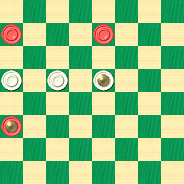Small, Square, Two Inches of Ivory

The famous British novelist of the late 18th and early 19th century, Jane Austen, spoke of her writer's canvas as a "small, square, two inches of ivory." By this she seemed to have meant that her works were limited in scope and in some sense "miniatures" based on the society in which she lived.
But this is a checker column, not a literary review, and we bring up Miss Austen only as a point of comparison to miniatures in checkers. They too deliberately limit their scope, but, like Jane Austen's famed novels, have no lack of intricacy, depth, and ultimately, charm.
Today we publish a Checker School study taken from the pages of Ben Boland's Famous Positions in the Game of Checkers. It's indeed a small square of ivory with much appeal and value. Here's the position.

WHITE
White to Play and Draw
W:W13,14,K15:B5,7,K21.
Can you find the White draw in this deceptively simple setting? You needn't be a Victorian gentleman or lady to find the answer; pure skill at checkers is what's required. When you've arrived at your solution, click Read More for the correct procedure accompanied not by harpischord or pianoforte, but instead a trio of sample games and extensive explanatory notes.![]()
Solution
The position is attributed to one W. J. Wray.
14-9, 5-14---E, 13-9, 14-17, 9-5, 21-25, 5-1, 25-22, 1-5---J, 17-21, 5-9, 21-25, 9-5, 25-30, 5-9, 30-25, 9-5, 22-17, 5-9, 25-21, 9-6. White Draws.
Game: 10-14, 22-18, 6-10, 25-22, 1-6, 29-25, 11-15, 18-11, 8-15, 24-20, 3-8 20-16, 12-19, 23-16, 8-11, 16-12, 11-16, 27-23, 16-20, 31-27, 9-13, 23-18, 14-23, 27-11, 7-16, 22-18, 6-9, 32-27, 9-14, 18-9, 5-14, 25-22, 2-7, 27-23, 14-17, 21-14, 10-17, 22-18, 17-22, 26-17, 13-22, 18-15, 22-26, 23-18, 26-31, 15-11, 7-10, 11-7, 31-27, 7-2, 27-23, 12-8, 23-14, 2-6, 4-11, 6-8, 16-19, 30-26, 14-18---A, 8-12. Forms above position, colors reversed. A. Herman and H. Freyer.
Game: 10-15, 21-17, 9-13, 17-14, 6-10, 23-18, 10-17, 25-21, 11-16, 21-14, 16-20, 18-11, 8-15, 24-19, 15-24, 28-19, 1-6, 29-25, 6-10, 25-21, 10-17, 21-14, 2-6, 30-25, 4-8, 25-21, 6-10, 32-28, 10-17, 21-14, 8-11, 22-17, 13-22, 26-17, 11-15, 19-10, 5-9, 14-5, 7-21, 5-1, 21-25, 1-6, 3-7---B, 27-23, 12-16---C, 23-18, 25-30, 6-2---D, 7-11, 2-7, 30-25, 7-10, 25-22, 10-15, 16-19, 15-8, 22-25, 31-26, 15-18, 8-12. Forms above position, colors reversed. Game No. 473, the New Draughts World, Jan. 1940.
Game: 11-15, 23-19, 8-11, 27-23, 4-8, 22-18, 15-22, 25-18, 10-15, 19-10, 6-22, 26-17, 11-15, 17-13, 9-14, 24-19---F, 15-24, 28-19, 7-10, 29-25, 3-7, 30-26, 8-11, 26-22, 11-15, 32-28, 15-24, 28-19, 14-17, 21-14, 10-26, 31-22, 7-11, 25-21---G, 11-16, 22-17, 1-6*, 19-15, 16-19*, 23-16, 12-19, 15-11, 19-23, 11-8, 23-26, 8-3, 26-30, 3-8, 30-26, 8-11, 26-22 (Forms D. Robertson Position, with Black to Play and Win), 11-15, 22-25---H, 15-18*, 6-10---I, 17-14, 10-17, 21-14, 2-7, 18-15, 25-21. Forms above position. W. F. Ryan, Championship Checkers Simplified.
A---Herman played 20-24 to a draw.
B---Left as drawn in Denvir's Three Move Guide.
C---This forms No. 295 by C. H. Smith, in the New Draughts World, given to lose, and 25-30 to draw.
D---L. S. Hart has shown in Feb. 29, 1940, "Perry Count Times," that 6-9, 7-11, 9-14, 30-25, 31-27, 25-22, 18-15, etc. White Wins.
E---With the move different it is a win by R. D. Petterson. A position that baffled Lyman, Martins and Wyllie, see Page 23, Note C.
F---29-25*, 7-10, 25-22, 3-7, 22-17, 8-11, 23-19, 11-16, 31-27. Drawn. W. F. R.
G---22-18, 11-16, 18-15, 16-20, 15-10, 20-24, 23-18, 24-27, 18-15, 2-6, 10-7, 27-31, 7-3, 31-27, 15-11, 27-24. N. Stephens won from W. Ryan.
H---2-7*, 15-19, 22-18, 19-24, 18-23, etc. Black Wins. W. Ryan.
I---Now Problem No. 68 in the New Checkergram, Sept. 1933, by W. F. Ryan, colors reversed.
J---W. M. Steele in the New Draughts World, February 1940, suggests (incorrectly---Ed.) 1-6 to draw also; 1-6, 7-10, 15-19, 10-14, 6-10, now Steele plays 22-25---K, 19-23, 25-30---L, 10-6, 17-22, 9-6, 14-17, 9-14, 17-21, 14-17, 22-26---M, 17-22, 26-31, 22-25, 31-26, 23-27. Drawn as Problem No. 95 by T. J. Brown, in Gould's Problem Book. J. A. Sweeny.
K---But this wins; 22-18---N, 19-16, 18-23, 10-15 (anything else allows 14-18), 23-26, 15-10,17-22,10-17,26-30. Black Wins. Ben Boland.
L---25-21, 10-6 (or 23-26, 14-18, 10-14, 18-22, 26-30, 22-25, 14-10, 25-29, 10-14, 17-22, 14-10, 21-17, 30-25. Drawn. Boland), 17-22, 9-6, 14-17, 9-13, 21-25, 23-26. Drawn. J. A. Sweeny. This theme is illustrated on Page 26, "Boland's Familiar Themes."
M---22-25, 17-22, 25-29, 23-18, 30-25, 22-26, 25-30, 26-22. Drawn. See Payne's Position, Page 25 "Familiar Themes."
N---This may come from a position by J. A. Sweeny, and is a dual, No. 184 the American Checker Review, Vol. 2, Dec. 1889, colors reversed; Black---Kings 14, 23, and White---16, 19, King 4. White to play and win; 4-8, 14-10, 8-11*, 10-14, 11-7* (but 11-15 wins too), 14-18, 7-3*, 18-22, 8-12, 23-27, 16-11, 27-24, 19-15. White Wins.
W. J. Wray's position may be found as No. 239 in Horsfall's Problem Book, but I believe it was shown about 1903 in the "Sheffield Independent" where Wray was Editor. He died in 1905.
Compare to the D. Robertson Position where Wray's position may be a variation.
Both positions were given in an extensive compilation by the writer in W. Ryan's, "The American Checkerist," Vol. 1, No. 6, Aug. - Sept. 1939.
You can email the Webmaster with comments on this article.